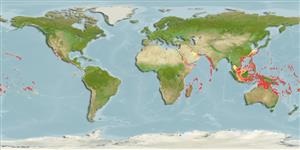>
Aulopiformes (Grinners) >
Synodontidae (Lizardfishes) > Synodontinae
Etymology: Synodus: Greek, syn, symphysis = grown together + Greek, odous = teeth (Ref. 45335); dermatogenys: Name from latin meaning unfading; referring to the markings on the pelvic fins that persist even in preserved specimens..
More on author: Fowler.
Environment: milieu / climate zone / depth range / distribution range
Écologie
marin récifal; profondeur 1 - 91 m (Ref. 86942). Tropical; 30°N - 32°S
Indo-Pacific: Red Sea to the Hawaiian, Line, Marquesan, and Tuamoto islands, north to Ryukyu Islands, south to Lord Howe; including Micronesia (Ref. 2334). Range extend to Southeast Atlantic, Algoa Bay, South Africa (Ref. 11228). Most authors misidentified this species as Synodus variegatus (Lacepède).
Taille / Poids / Âge
Maturity: Lm ? range ? - ? cm
Max length : 24.0 cm TL mâle / non sexé; (Ref. 11228)
Épines dorsales (Total): 0; Rayons mous dorsaux (Total): 11-13; Épines anales 0; Rayons mous anaux: 8 - 10. Body brownish above, with 7 irregular blackish bars (Ref. 11228). Cheek usually not scaled to preopercular margin; membranous flap on anterior nostrils long and slender; pectoral fins not reaching a line connecting origins of dorsal and pelvic fins.
Common on sand or sand-rubble areas of lagoon and seaward reefs to over 20 m depth (Ref. 1602, 9710, 48635). Benthic (Ref. 58302). Feeds on shrimps and small fishes (Ref. 89972). Frequently buries in sand leaving only eyes and nostrils exposed (Ref. 9710, 48635). Generally solitary (Ref. 1602). Sometimes in pairs or small groups (Ref 90102).
Life cycle and mating behavior
Maturité | Reproduction | Frai | Œufs | Fécondité | Larves
Generally solitary, but up to four males may have been observed courting a single larger female. A courting male may station itself atop a female and puff out its opercula and spread its fins in a display of aggression towards other males (Ref. 37816).
Randall, J.E., G.R. Allen and R.C. Steene, 1990. Fishes of the Great Barrier Reef and Coral Sea. University of Hawaii Press, Honolulu, Hawaii. 506 p. (Ref. 2334)
Statut dans la liste rouge de l'IUCN (Ref. 130435)
Menace pour l'homme
Harmless
Utilisations par l'homme
Plus d'informations
RéférencesAquacultureProfil d'aquacultureSouchesGénétiqueElectrophoresesHéritabilitéPathologiesTraitementNutrientsMass conversion
Outils
Articles particuliers
Télécharger en XML
Sources Internet
Estimates based on models
Preferred temperature (Ref.
123201): 24.3 - 28.8, mean 27.5 °C (based on 750 cells).
Phylogenetic diversity index (Ref.
82804): PD
50 = 0.5000 [Uniqueness, from 0.5 = low to 2.0 = high].
Bayesian length-weight: a=0.00617 (0.00387 - 0.00981), b=3.22 (3.09 - 3.35), in cm total length, based on LWR estimates for this species & Genus-body shape (Ref.
93245).
Niveau trophique (Ref.
69278): 4.2 ±0.7 se; based on diet studies.
Résilience (Ref.
120179): Haut, temps minimum de doublement de population inférieur à 15 mois (Preliminary K or Fecundity.).
Fishing Vulnerability (Ref.
59153): Low vulnerability (14 of 100).
Nutrients (Ref.
124155): Calcium = 64.1 [23.5, 135.4] mg/100g; Iron = 0.578 [0.199, 1.239] mg/100g; Protein = 15.8 [12.9, 18.2] %; Omega3 = 0.0675 [, ] g/100g; Selenium = 34.7 [13.6, 80.4] μg/100g; VitaminA = 109 [28, 357] μg/100g; Zinc = 1.02 [0.59, 1.55] mg/100g (wet weight);
